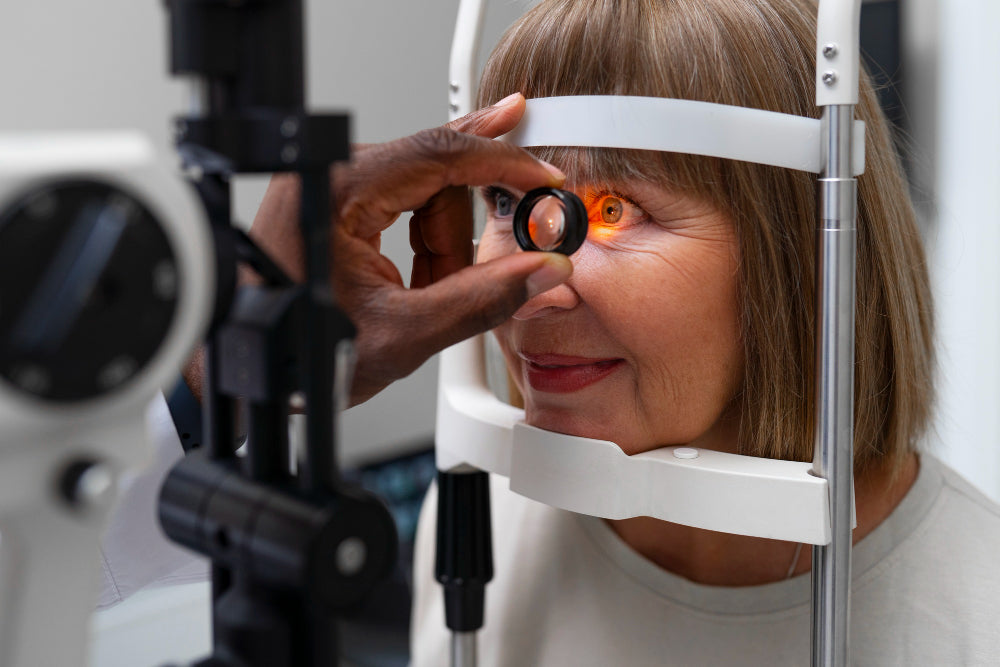Have you been told your vision is so bad that you are not a candidate for LASIK? Does your line of work prevent you from wearing glasses and you can’t do contacts? If you're nodding along, then Refractive Lens Exchange (RLE) might be the game-changer you've been looking for.
What is RLE in medical terms? Refractive Lens Exchange (RLE), sometimes referred to as refractive lens replacement, is a surgical procedure where the eye's natural lens is replaced with an artificial lens to address high amounts of refractive error, such as high amounts of nearsightedness, farsightedness, and astigmatism.
This procedure will be a good fit if you seek to reduce dependence on glasses or contact lenses and are willing to go through a surgical procedure similar to cataract surgery.
In this post, we'll find out more about RLE surgery. We aim to explore its effectiveness, safety, recovery time, and all the details you need to know to make an informed decision about your eye health.
What is RLE Surgery?
Refractive Lens Exchange, commonly known as RLE, is a surgical procedure where your eye's natural lens is replaced with an artificial one.
This isn't just any artificial lens, but a custom-designed intraocular lens (IOL) that helps correct refractive errors such as:
- Astigmatism
- Myopia (nearsightedness)
- Hyperopia (farsightedness)
- Presbyopia (the need for reading glasses as you age)
Is RLE Eye Surgery Safe?

We know what you're thinking: "Is this procedure safe?" RLE is a well-established and safe procedure with a high success rate.
According to recent studies, the safety profile of RLE is comparable to that of cataract surgery, a widely performed and trusted procedure in eye care. So rest assured the success rate is high.
Refractive Lens Exchange Success Rate
And the golden question – how effective is RLE? Here are the stats: studies have shown that RLE boasts an impressive success rate of over 95% with patients experiencing significantly improved vision post-surgery.
So, you can fully expect to reduce your dependence on glasses and contact lenses with the help of RLE.
Refractive Lens Exchange Recovery Time
Now let's discuss the road to recovery. After undergoing RLE most patients can expect a relatively quick healing process. While individual recovery times may vary, most people report noticeable improvements in their vision within a few days post-surgery. It's like hitting the refresh button on your eyes – quick and efficient. It can be very rewarding.
Clarity Awaits: Transform Your Vision with Vision Source Rio's Expert Team!
If you're ready to leap toward clearer vision and reduce your dependence on glasses and contacts, why not reach out to Vision Source Rio for top-quality eye care services?
With a skilled team dedicated to enhancing your vision and providing personalized care, Vision Source Rio is your go-to destination for all things eye-related. Book your consultation and begin your journey to sharper brighter vision today!
What Are the Benefits of RLE Surgery?

The benefits of refractive lens exchange surgery are many fold, offering a transformative solution to vision issues and reducing dependence on corrective eyewear. Here are some benefits highlighted in the sources provided:
- Improved Visual Quality: Refractive lens exchange provides better visual quality and a more permanent solution to vision problems.
- Reduction in Dependence on Glasses: Patients undergoing RLE have the potential to significantly reduce their reliance on glasses or contact lenses.
- Treatment for Various Vision Difficulties: RLE can address a range of vision difficulties, such as nearsightedness, farsightedness, astigmatism, and presbyopia.
- Cataract Removal: RLE involves replacing the natural lens with an intraocular lens, which not only corrects vision but also removes any existing cataracts.
- Alternative to LASIK: RLE provides a practical option for people who are not suitable candidates for LASIK due to high refractive error and thin corneas.
- High Success Rates: RLE surgery patients usually experience high success rates and improved vision outcomes.
- Long-Term Solution: RLE is considered a long-term solution, potentially eliminating the need for future eye surgeries like cataract surgery.
In essence, refractive lens exchange surgery offers a comprehensive solution for vision correction, enhancing visual acuity, reducing dependency on corrective eyewear, and providing lasting benefits for individuals seeking clearer uncorrected vision.
How Does Refractive Lens Exchange Surgery Work?

Here’s how refractive lens exchange (RLE) surgery works:
- The procedure is a one day surgery, typically taking less than 30 minutes per eye.
- The patient is given a light sedative, and their eye is numbed with anesthetic eye drops to ensure comfort and relaxation.
- The surgeon creates a small, less than 3 mm incision in the eye to access the natural lens.
- Using an ultrasound probe, the surgeon breaks up and removes the natural lens through the incision in phacoemulsification.
- The surgeon then inserts a replacement artificial intraocular lens (IOL) through the small incision. The IOL is flexible and can be folded to fit through the tiny opening.
- Once inside the eye, the IOL unfolds and is positioned in place, permanently replacing the natural lens.
- The incision is so tiny that it typically requires no stitches, as it will heal within 72 hours.
- After the procedure, the patient is prescribed anti-inflammatory eye drops to aid healing.
RLE surgery involves removing the eye's natural lens and replacing it with a customized artificial IOL to correct refractive errors and improve vision, similar to cataract surgery but without cataracts.
What are the Risks and Complications of RLE Surgery?

The risks and complications associated with refractive lens exchange (RLE) surgery include:
General Risks: Like any surgical procedure, RLE carries a degree of risk, like infection, bleeding, and discomfort.
Short-Term Side Effects: Common short-term side effects after RLE surgery may include dry, itchy eyes, blurry vision, and light sensitivity, which typically resolve within a few weeks.
Specific Risks of RLE Surgery:
- Loss of vision
- Droopy eyelid
- Detached retina
- Visual disturbances
- Swollen cornea or retina
- Dislocated intraocular lens
- Temporary increase in eye pressure
- Posterior Capsule Opacification (PCO)
Severe Vision Loss: Severe vision loss from RLE surgery is rare, occurring in approximately 1 in 500 people.
Specific Complications: The complication spectrum of RLE is similar to that of cataract surgery but may have some differences, primarily when implemented in very short or very long eyes with a significantly lower average patient age.
While RLE is generally considered safe and effective, it's crucial for individuals considering this procedure to know about these potential risks and complications.
Consulting with a skilled eye care professional and understanding the individualized risks based on one's health and eye condition is imperative in making an informed decision about undergoing RLE surgery.
Wrapping Up: Refractive Lens Exchange (RLE): A Clear Vision into the Future
Wrapping it up, RLE is particularly beneficial for individuals with high refractive errors or those seeking a permanent solution to their vision woes. It's like giving your eyes a new lens through which to see the world!
So, there you have it – a glimpse into the transformative world of Refractive Lens Exchange. A future potentially filled with clarity and precision awaits you.
Your eyes deserve the best, and RLE might be the key to unlocking a world of visual freedom. Cheers to a brighter tomorrow – quite literally!
Also Read:





